
The Republican Guard is part of the French National Gendarmerie. It is responsible for special security duties in the Paris area and for providing guards of honour at official ceremonies of the French Republic.

Palacio de La Moneda, or simply La Moneda, is the seat of the President of the Republic of Chile. It also houses the offices of three cabinet ministers: Interior, General Secretariat of the Presidency, and General Secretariat of the Government. Located in downtown Santiago, it occupies an entire block in the Civic District, bordered by Moneda street to the north, Morandé street to the east, Alameda del Libertador Bernardo O'Higgins to the south, and Teatinos street to the west.
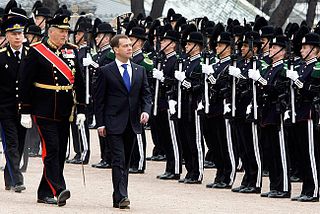
In some militaries, foot guards are senior infantry regiments. Foot guards are commonly responsible for guarding royal families or other state leaders, and they also often perform ceremonial duties accordingly, but at the same time are combat soldiers.

Guard mounting, changing the guard, or the changing of the guard, is a formal ceremony in which sentries performing ceremonial guard duties at important institutions are relieved by a new batch of sentries. The ceremonies are often elaborate and precisely choreographed. They originated with peacetime and battlefield military drills introduced to enhance unit cohesion and effectiveness in the late 17th and early 18th centuries.

The Government Palace, also known as the House of Pizarro, is the seat of the executive branch of the Peruvian government, and the official residence of the president of Peru. The palace is a stately government building, occupying the northern side of the Plaza Mayor in Peru's capital city, Lima. Set on the Rímac River, the palace occupies the site of a very large huaca that incorporated a shrine to Taulichusco, the last kuraka of Lima.
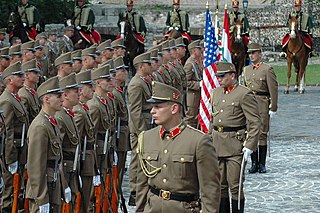
A guard of honour (GB), also honor guard (US), also ceremonial guard, is a group of people, usually military in nature, appointed to receive or guard a head of state or other dignitaries, the fallen in war, or to attend at state ceremonials, especially funerals. In military weddings, especially those of commissioned officers, a guard, composed usually of service members of the same branch, form the sabre arch. In principle, any military unit could act as a guard of honour. However, in some countries certain units are specially designated to serve as a guard of honour, as well as other public duties.

The Presidential Security Force of Indonesia is one of the Central Executive Agencies of the Indonesian National Armed Forces responsible for proximate security and escort towards the head of state and VVIP in Indonesia, which includes the President, Vice President with their immediate families, former Presidents and Vice Presidents, and visiting foreign heads of state. Paspampres is based in Jakarta, and its personnel are drawn from deputized best-chosen officers, soldiers, seamen, marines, and airmen from special forces and/or special units within the Indonesian National Armed Forces (TNI). It is commanded by a two-star military general.
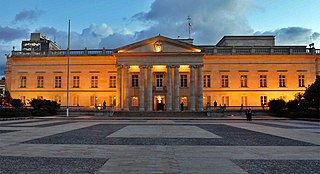
The Palacio de Nariño or Casa de Nariño is the official home and principal workplace of the President of Colombia. It houses the main office of the executive branch and is located in the capital city of Bogotá, Colombia. It was dedicated in 1908 after being constructed on the site of the house where Antonio Nariño was born. The design was made by architects Gaston Lelarge, a French-born former pupil of Charles Garnier, and Julián Lombana.

The Royal Guard is an independent regiment of the Spanish Armed Forces that is dedicated to the protection of the King of Spain and members of the Spanish royal family. It currently has a strength of 1,500 troops. While the guard does participate in parades and other ceremonial events, it is a fully functional combat unit. Its members are recruited from the ranks of all three branches of the Spanish Armed Forces and receive the same combat training as regular soldiers.

Carabineros de Chile are the Chilean national law enforcement gendarmerie, who have jurisdiction over the entire national territory of the Republic of Chile. Created in 1927, their mission is to maintain order and enforce the laws of Chile. They reported to the Ministry of National Defense through the Undersecretary of Carabineros until 2011 when the Ministry of the Interior and Public Security gained full control over them. They are in practice separated fully from the three other military branches by department but still are considered part of the armed forces. Chile also has an investigative police force, the Investigations Police of Chile, also under the Interior and Public Security Ministry; a Maritime Police also exists for patrol of Chile's coastline.
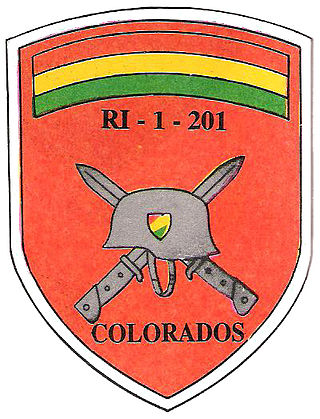
The 1st Regiment of Foot Infantry "Bolivian Colorados" National Presidential Escort Regiment of the Bolivian Army, formerly the 39th Line Infantry Battalion "Colorados" is one of the Army's oldest and most prestigious infantry regiments. It is headquartered in La Paz's Miraflores District, and is under the direct supervision of Bolivian Army headquarters.

For more than a century the Military Parade of Chile or Great Military Parade of Chile has been a tradition within the Independence Day holidays in Chile. It is held in Santiago, Chile's O'Higgins Park on September 19 yearly in honor of the Glories of the Chilean Army with a military parade involving not just the ground forces but by the rest of the Chilean Armed Forces: the Chilean Navy, the Chilean Air Force, and the Carabineros de Chile. It is also in honor of the anniversary of the formal inauguration on that day in 1810 of the First Government Junta, which witnessed the first military parade of the independent nation at the Plaza de Armas, Santiago. It is the final act of the national independence celebrations, which are broadcast through TV and the Internet and radio.

The "Mariscal Domingo Nieto" Cavalry Regiment Escort is the Household Cavalry and Dragoon Guards regiment of the Peruvian Army since 1904, having been inactive from 1987 to 2012.

The Palace of Cerro Castillo is the official country retreat and summer residence of the President of Chile. Built in 1929 in the Spanish Colonial Revival style, it is situated atop Cerro Castillo hill located in Viña del Mar and has been designated as a national and municipal historic monument.
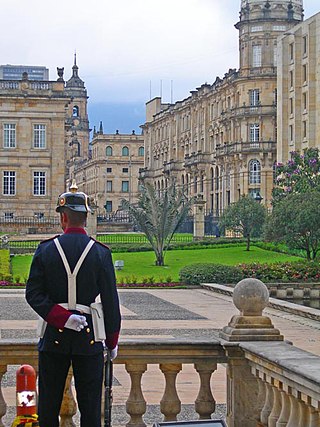
The 37th Infantry Battalion "Guardia Presidencial" is the President of Colombia's honor guard service unit under the National Army of Colombia. It is composed of five companies, a historical company and one artillery battery plus a military band, a fanfare trumpet section and a Corps of Drums. It is stationed at the Casa de Nariño in Bogotá and carries the traditions of Simon Bolivar's infantry guards company raised in the midst of the Spanish American wars of independence in 1815.

The Presidential Escort Group "Granaderos de Tarqui" is the President of Ecuador's honour guard service regiment, which protects the Carondelet Palace in Quito. Granaderos de Tarqui, means Tarqui Grenadiers in Spanish.
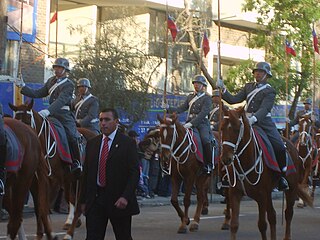
The 1st Cavalry Regiment "Grenadiers" is the senior cavalry regiment of the Chilean Army, which serves as the Horse Guards unit providing the ceremonial escort in parades and ceremonies to the President of Chile, the Supreme Commander of the Chilean Armed Forces. It provides the guard during flag raising ceremonies monthly in Santiago, the national capital. Together with the 3rd Cavalry Regiment "Hussars" it forms the remaining mounted components of the army in active service.
The Group of Personal Friends, sometimes referred to by the Spanish acronym GAP, was the informal name of an armed guard of the Socialist Party of Chile maintained from 1970 to 1973 for the protection of Salvador Allende. The GAP was trained and equipped by Cuba and initially composed of ex-guerrilla fighters.
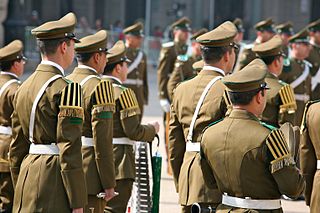
The National Band of the Carabineros sometimes referred to as the Orfeón Nacional is the public police band of the Carabineros de Chile, the national police force of the Republic of Chile. It is generally seen as the premiere representative marching band of the force, performing at state occasions. At the command of the band is Colonel David Ormeño Sepúlveda.




















